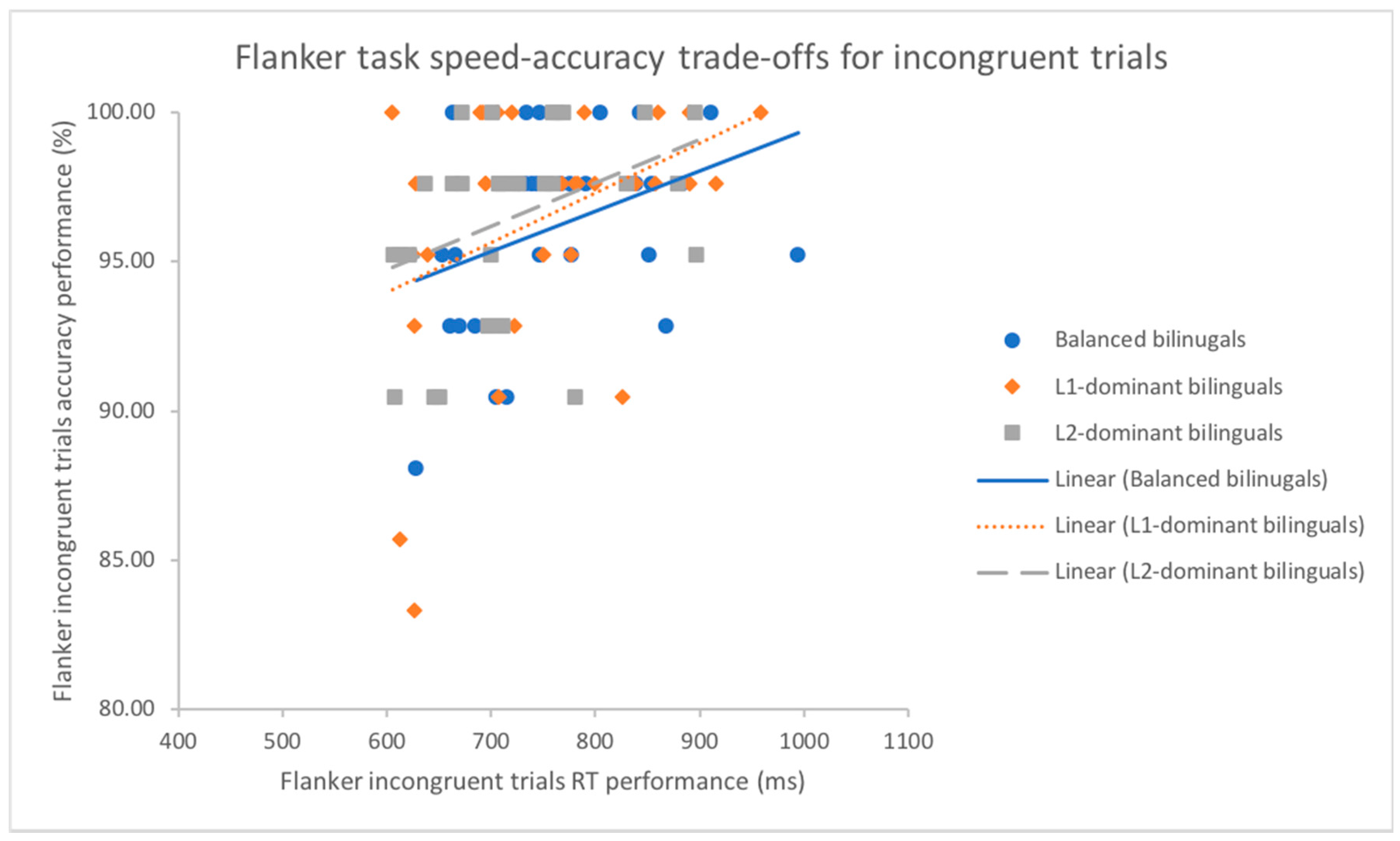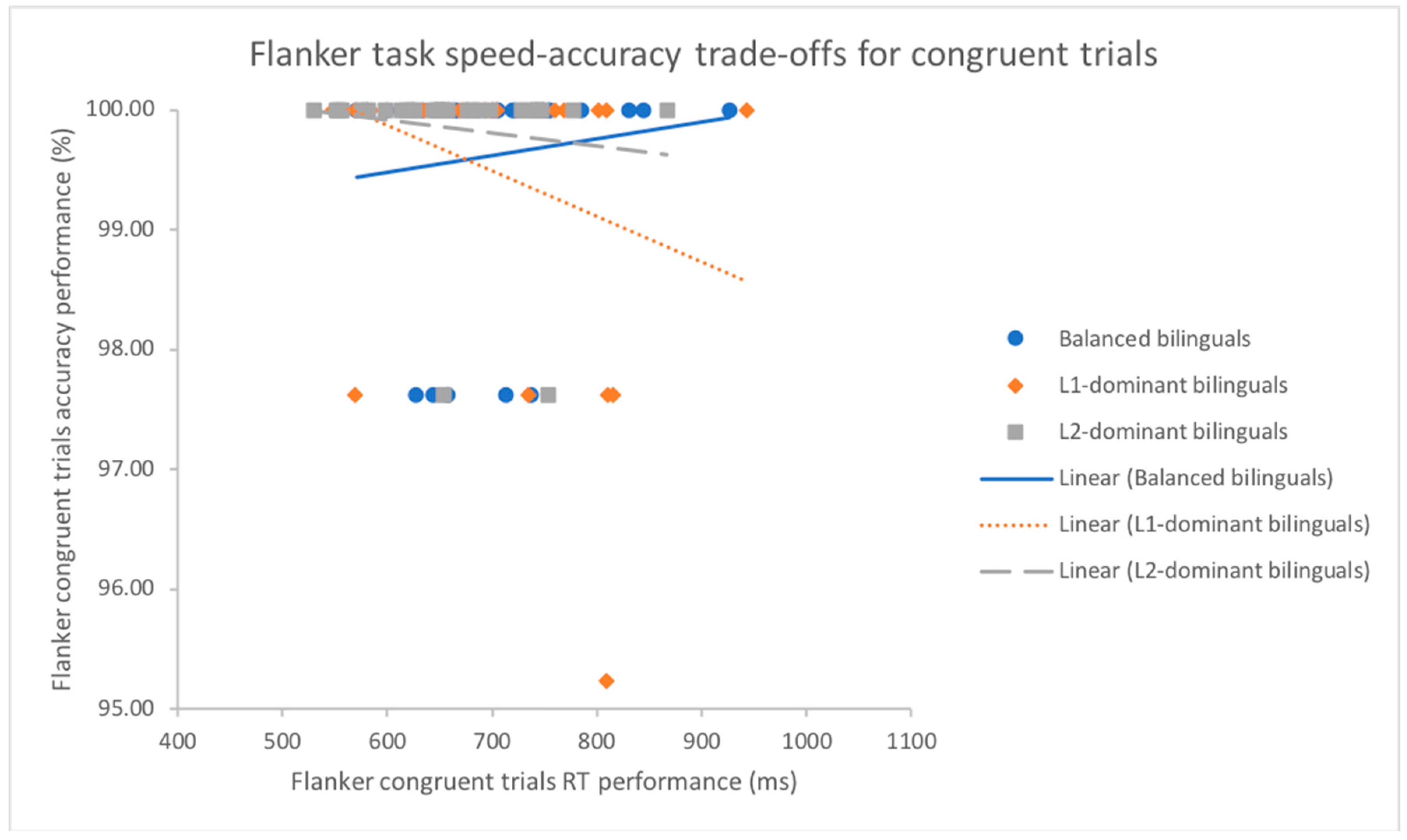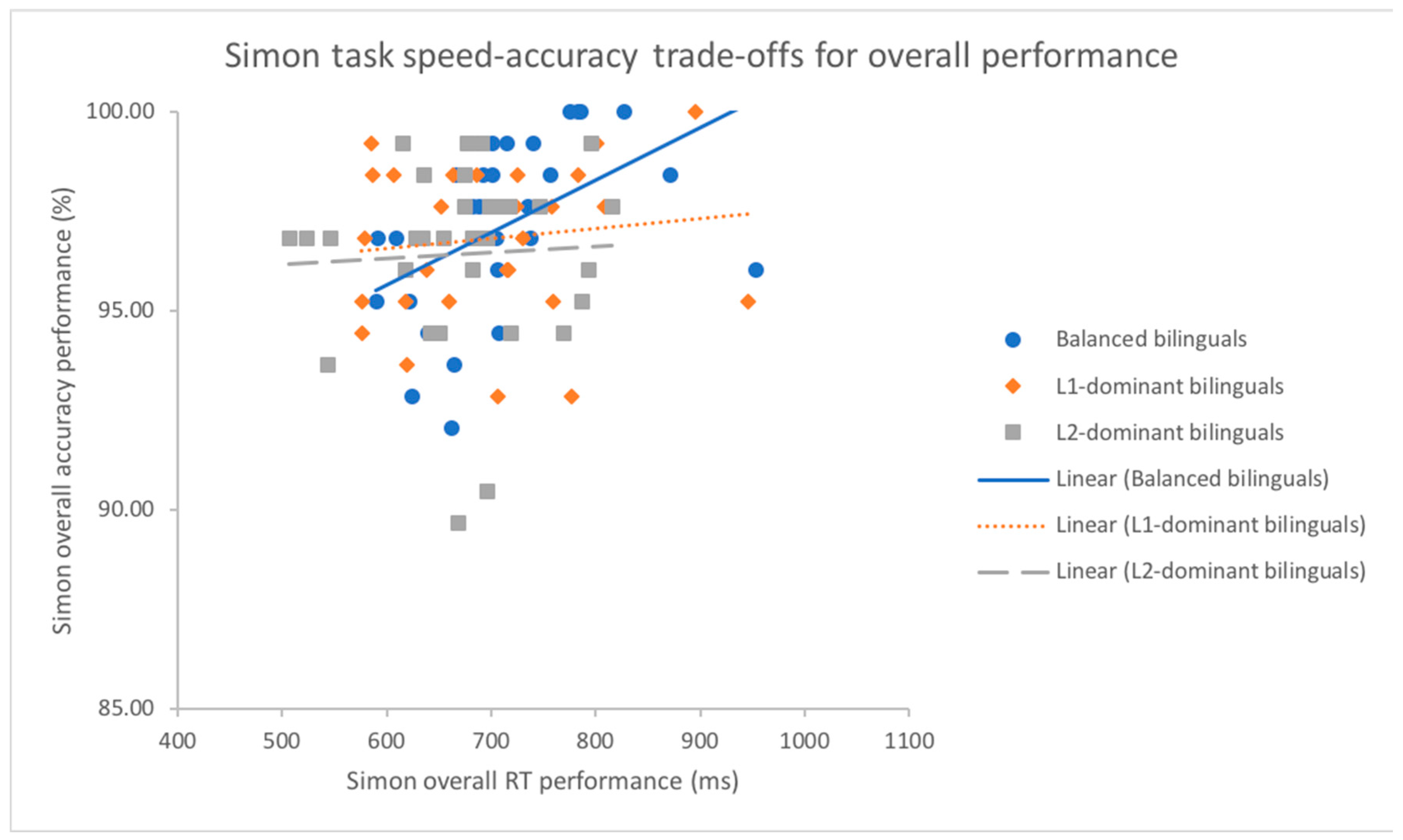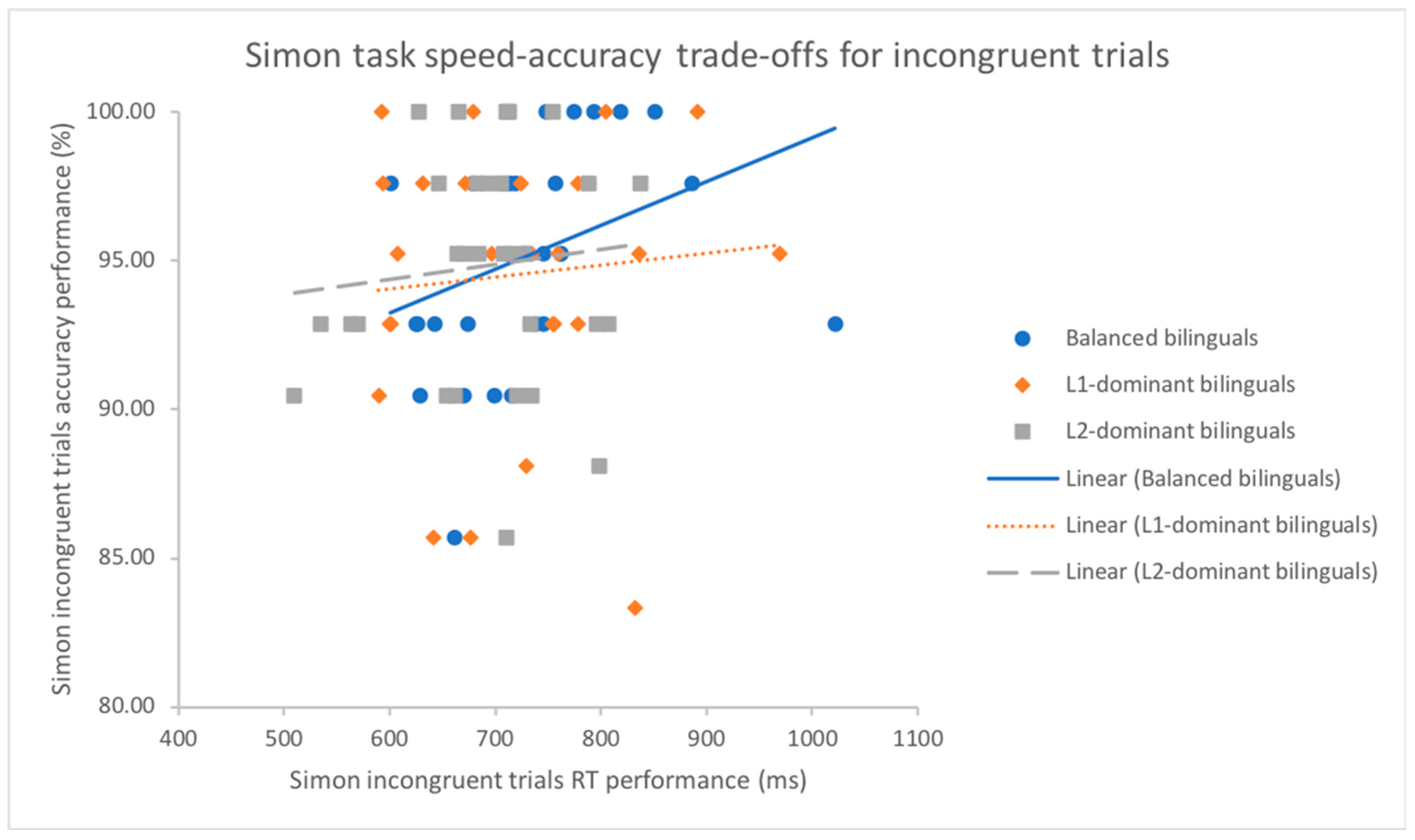Relationship between Language Dominance and Stimulus-Stimulus or Stimulus-Response Inhibition in Uyghur-Chinese Bilinguals with an Investigation of Speed-Accuracy Trade-Offs
Abstract
1. Introduction
1.1. Previous Studies on the Importance of Sociolinguistic Factors in Bilingual Advantage in Regional Minority Languages
1.2. Assessing Bilingual Language Dominance
1.3. Present Study
2. Materials and Methods
2.1. Participants
2.1.1. Language Profiles
2.1.2. Measures of Bilingual Language Dominance
2.2. Procedure and Materials
2.2.1. Raven’s Progressive Matrices
2.2.2. Flanker Task
2.2.3. Simon Task
3. Results
3.1. Flanker Task
3.2. Simon Task
4. Discussion
4.1. No Effect of Bilingual Dominance Types on Speed and Accuracy Performances in Cognitive Control Tasks
4.2. Differences of Speed-Accuracy Trade-Offs in Bilingual Dominance Type
4.3. Strategy Differences in Stimulus-Stimulus and Stimulus-Response Inhibition Tasks
5. Conclusions
Author Contributions
Funding
Conflicts of Interest
References
- Green, D.W. Mental control of the bilingual lexico-semantic system. Biling. Lang. Cogn. 1998, 1, 67–81. [Google Scholar] [CrossRef]
- Bialystok, E.; Craik, F.I.M.; Luk, G. Bilingualism: Consequences for mind and brain. Trends Cogn. Sci. 2012, 16, 240–250. [Google Scholar] [CrossRef] [PubMed]
- Costa, A.; Hernandez, M.; Costa-Faidella, J.; Sebastian-Galles, N. On the bilingual advantage in conflict processing: Now you see it, now you don’t. Cognition 2009, 113, 135–149. [Google Scholar] [CrossRef]
- Dijkstra, T.; van Heuven, W.J.B. The architecture of the bilingual word recognition system: From identification to decision. Biling. Lang. Cogn. 2002, 5, 175–197. [Google Scholar] [CrossRef]
- Dijkstra, T.; Wahl, A.; Buytenhuijs, F.; van Halem, N.; Al-jibouri, Z.; de Korte, M.; Rekké, S. Multilink: A computational model for bilingual word recognition and word translation. Biling. Lang. Cogn. 2018, 1–23. [Google Scholar] [CrossRef]
- Paap, K.R.; Johnson, H.A.; Sawi, O. Bilingual advantages in executive functioning either do not exist or are restricted to very specific and undetermined circumstances. Cortex 2015, 69, 265–278. [Google Scholar] [CrossRef] [PubMed]
- Bialystok, E. Effect of bilingualism and computer video game experience on the Simon task. Can. J. Exp. Psychol. 2006, 60, 68–79. [Google Scholar] [CrossRef] [PubMed]
- Schroeder, S.; Marian, V. A bilingual advantage for episodic memory in older adults. J. Cogn. Psychol. 2012, 24, 591–601. [Google Scholar] [CrossRef] [PubMed]
- Costa, A.; Hernández, M.; Sebastián-Gallés, N. Bilingualism aids conflict resolution: Evidence from the ANT task. Cognition 2008, 106, 59–86. [Google Scholar] [CrossRef] [PubMed]
- Engel de Abreu, P.M.; Cruz-Santos, A.; Tourinho, C.J.; Martin, R.; Bialystok, E. Bilingualism enriches the poor: Enhanced cognitive control in low-income minority children. Psychol. Sci. 2012, 23, 1364–1371. [Google Scholar] [CrossRef]
- Luk, G.; de Sa, E.; Bialystok, E. Is there a relation between onset age of bilingualism and enhancement of cognitive control? Biling. Lang. Cogn. 2011, 14, 588–595. [Google Scholar] [CrossRef]
- Tao, L.; Marzecová, A.; Taft, M.; Asanowicz, D.; Wodniecka, Z. The efficiency of attentional networks in early and late bilinguals: The role of age of acquisition. Front. Psychol. 2011, 2, 1–19. [Google Scholar] [CrossRef] [PubMed]
- Lehtonen, M.; Soveri, A.; Laine, A.; Järvenpää, J.; de Bruin, A.; Antfolk, J. Is bilingualism associated with enhanced executive functioning in adults? Psychol. Bull. 2018, 144, 394–425. [Google Scholar] [CrossRef]
- Blom, E.; Boerma, T.; Bosma, E.; Cornips, L.M.E.A.; Everaert, E. Cognitive advantages of bilingual children in different sociolinguistic contexts. Front. Psychol. 2017, 8, 1–12. [Google Scholar] [CrossRef] [PubMed]
- Gathercole, V.C.M.; Thomas, E.M.; Kennedy, I.; Prys, C.; Young, N.; Viñas Guasch, N.; Roberts, E.J.; Hughes, E.K.; Jones, L. Does language dominance affect cognitive performance in bilinguals? Lifespan evidence from preschoolers through older adults on card sorting, Simon and metalinguistic tasks. Front. Psychol. 2014, 5, 1–14. [Google Scholar] [CrossRef] [PubMed]
- Wu, Y.J.; Thierry, G. Fast Modulation of Executive Function by Language Context in Bilinguals. J. Neurosci. 2013, 33, 13533–13537. [Google Scholar] [CrossRef] [PubMed]
- Green, D.W.; Abutalebi, J. Language control in bilinguals: The adaptive control hypothesis. J. Cogn. Psychol. 2013, 25, 515–530. [Google Scholar] [CrossRef] [PubMed]
- Kornblum, S.; Stevens, G.T.; Whipple, A.; Requin, J. The effects of irrelevant stimuli: 1. The time course of stimulus–stimulus and stimulus–response consistency effects with Stroop-like stimuli, Simon-like tasks and their factorial combinations. J. Exp. Psychol. Hum. Percept. Perform. 1999, 25, 688–714. [Google Scholar] [CrossRef][Green Version]
- Antón, E.; Duñabeitia, J.A.; Estévez, A.; Hernández, J.A.; Castillo, A.; Fuentes, L.J.; Davidson, D.J.; Carreiras, M. Is there a bilingual advantage in the ANT task? Evidence from children. Front. Psychol. 2014, 5, 1–12. [Google Scholar] [CrossRef]
- Duñabeitia, J.A.; Hernández, J.A.; Antón, E.; Macizo, P.; Estévez, A.; Fuentes, L.J.; Carreiras, M. The inhibitory advantage in bilingual children revisited: Myth or reality? J. Exp. Psychol. 2014, 61, 234–251. [Google Scholar] [CrossRef]
- Antoniou, K.; Grohmann, K.K.; Kambanaros, M.; Katsos, N. The effect of childhood bilectalism and multilingualism on executive control. Cognition 2016, 149, 18–30. [Google Scholar] [CrossRef]
- Hamers, J.F.; Blanc, H.A. Bilinguality and Bilingualism, 2nd ed.; Cambridge University Press: New York, NY, USA, 2000. [Google Scholar]
- Luk, G.; Bialystok, E. Bilingualism is not a categorical variable: Interaction between language proficiency and usage. J. Cogn. Psychol. 2013, 25, 605–621. [Google Scholar] [CrossRef]
- Deuchar, M.; Muntz, R. Factors accounting for code-mixing in an early developing bilingual. In Vulnerable Domains in Multilingualism; Muller, N., Ed.; John Benjamins: Amsterdam, The Netherlands, 2003; pp. 161–190. [Google Scholar]
- Dunn, A.L.; Fox Tree, J.E. A quick, gradient bilingual dominance scale. Biling. Lang. Cogn. 2009, 12, 273–289. [Google Scholar] [CrossRef]
- Grosjean, F. Studying Bilinguals; Oxford University Press: Oxford, UK, 2008. [Google Scholar]
- Pavlenko, A. The Bilingual Mind: And What It Tells us about Language and Thought; Cambridge University Press: Cambridge, UK, 2014. [Google Scholar]
- Treffers-Daller, J. Language dominance: The construct, its measurement and operationalisation. In Language Dominance in Bilinguals; Silva Corvalán, C., Treffers-Daller, J., Eds.; Cambridge University Press: Cambridge, UK, 2015; pp. 235–265. [Google Scholar]
- Poarch, G.J.; van Hell, J.G. Executive functions and inhibitory control in multilingual children: Evidence from second language learners, bilinguals and trilinguals. J. Exp. Child Psychol. 2012, 113, 535–551. [Google Scholar] [CrossRef] [PubMed]
- Bialystok, E.; Barac, R. Emerging bilingualism: Dissociating advantages for metalinguistic awareness and executive control. Cognition 2012, 122, 67–73. [Google Scholar] [CrossRef] [PubMed]
- Thomas-Sunesson, D.; Hakuta, K.; Bialystok, E. Degree of bilingualism modifies executive control in Hispanic children in the USA. Int. J. Biling. Educ. Biling. 2016, 20, 1–10. [Google Scholar] [CrossRef]
- Weber, R.C.; Johnson, A.; Riccio, C.A.; Liew, J. Balanced bilingualism and executive functioning in children. Biling. Lang. Cogn. 2016, 19, 425–431. [Google Scholar] [CrossRef]
- Tse, C.S.; Altarriba, J. The relationship between language proficiency and attentional control in Cantonese-English bilingual children: Evidence from Simon, Simon switching and working memory tasks. Front. Psychol. 2014, 5, 1–18. [Google Scholar] [CrossRef]
- Prior, A.; Goldwasser, N.; Ravet-Hirsh, R.; Schwartz, M. Executive functions in bilingual children: Is there a role for language balance. In Cognitive Control and Consequences of Multilingualism: Bilingual Processing and Acquisition; Schwieter, J.W., Ed.; John Benjamins Publishing Company: Amsterdam, The Netherlands, 2016; pp. 323–350. [Google Scholar]
- Bosma, E.; Hoekstra, E.; Versloot, A.P.; Blom, E. The Minimal and Short-Lived Effects of Minority Language Exposure on the Executive Functions of Frisian-Dutch Bilingual Children. Front. Psychol. 2017, 8, 1–11. [Google Scholar] [CrossRef]
- Rosselli, M.; Ardila, A.; Lalwani, L.; Vélez-Uribe, I. The effect of language proficiency on executive functions in balanced and unbalanced Spanish–English bilinguals. Biling. Lang. Cogn. 2016, 19, 489–503. [Google Scholar] [CrossRef]
- Gathercole, V.C.M.; Thomas, E.M.; Jones, L.; Guasch, N.V.; Young, N.; Hughes, E.K. Cognitive effects of bilingualism: Digging deeper for the contributions of language dominance, linguistic knowledge, socio-economic status and cognitive abilities. Int. J. Biling. Educ. Biling. 2010, 13, 617–664. [Google Scholar] [CrossRef]
- Videsott, G.; Della Rosa, P.A.; Wiater, W.; Franceschini, R.; Abutalebi, J. How does linguistic competence enhance cognitive functions in children? A study in multilingual children with different linguistic competences. Bilingualism 2012, 15, 884–895. [Google Scholar] [CrossRef]
- Marian, V.; Blumenfeld, H.K.; Kaushanskaya, M. The Language Experience and Proficiency Questionnaire (LEAP-Q): Assessing language profiles in bilinguals and multilinguals. J. Speech Lang. Hear. Res. 2007, 50, 940–967. [Google Scholar] [CrossRef]
- Vaid, J.; Menon, R. Correlates of bilinguals’ preferred language for mental computations. Span. Appl. Linguist. 2000, 4, 325–342. [Google Scholar]
- Paap, K.R.; Anders-Jefferson, R.; Mikulinsky, R.; Masuda, S.; Mason, L. On the encapsulation of bilingual language control. J. Mem. Lang. 2019, 105, 76–92. [Google Scholar] [CrossRef]
- Oschwald, J.; Schättin, A.; von Bastian, C.C.; Souza, A.S. Bidialectalism and Bilingualism: Exploring the Role of Language Similarity as a Link Between Linguistic Ability and Executive Control. Front. Psychol. 2018, 9. [Google Scholar] [CrossRef] [PubMed]
- Yow, W.Q.; Li, X. Balanced bilingualism and early age of second language acquisition as the underlying mechanisms of a bilingual executive control advantage: Why variations in bilingual experiences matter. Front. Psychol. 2015, 6, 1–12. [Google Scholar] [CrossRef]
- Paap, K.R. Bilingualism in cognitive science: The characteristics and consequences of bilingual language control. In The Cambridge Handbook of Bilingualism; De Houwer, A., Ortega, L., Eds.; Cambridge University Press: Cambridge, UK, 2018; pp. 435–465. [Google Scholar]
- Hilchey, M.D.; Klein, R.M. Are there bilingual advantages on nonlinguistic interference tasks? Implications for the plasticity of executive control processes. Psychon. Bull. Rev. 2011, 18, 625–658. [Google Scholar] [CrossRef] [PubMed]
- Freeman, M.R.; Blumenfeld, H.K.; Marian, V. Cross-linguistic phonotactic competition and cognitive control in bilinguals. J. Cogn. Psychol. 2017, 29, 783–794. [Google Scholar] [CrossRef] [PubMed]
- Blumenfeld, H.K.; Schroeder, S.R.; Bobb, S.C.; Freeman, M.R.; Marian, V. Auditory word recognition across the lifespan: Links between linguistic and non linguistic inhibitory control in bilinguals and monolinguals. Linguist. Approaches Biling. 2016, 6, 119–146. [Google Scholar] [CrossRef]
- Linck, J.A.; Schwieter, J.W.; Sunderman, G. Inhibitory control predicts language switching performance in trilingual speech production. Biling. Lang. Cogn. 2012, 15, 651–662. [Google Scholar] [CrossRef]
- Yang, J.; Ye, J.; Wang, R.; Zhou, K.; Wu, Y.J. Bilingual Contexts Modulate the Inhibitory Control Network. Front. Psychol. 2018, 9, 1–14. [Google Scholar] [CrossRef]
- Blumenfeld, H.K.; Marian, V. Cognitive control in bilinguals: Advantages in stimulus-stimulus inhibition. Biling. Lang. Cogn. 2014, 17, 610–629. [Google Scholar] [CrossRef]
- Struys, E.; Duyck, W.; Woumans, E. The Role of Cognitive Development and Strategic Task Tendencies in the Bilingual Advantage Controversy. Front. Psychol. 2018, 9, 1–11. [Google Scholar] [CrossRef]
- Meyer, D.E.; Osman, A.M.; Irwin, D.E.; Kounios, J. The dynamics of cognition and action-Mental processes inferred from speed accuracy decomposition. Psychol. Rev. 1988, 95, 183–237. [Google Scholar] [CrossRef]
- Hilchey, M.D.; Ivanoff, J.; Taylor, T.L.; Klein, R.M. Visualizing the temporal dynamics of spatial information processing responsible for the Simon effect and its amplification by inhibition of return. Acta Psychol. 2011, 136, 235–244. [Google Scholar] [CrossRef]
- Uemura, K.; Oya, T.; Uchiyama, Y. Effects of speed and accuracy strategy on choice step execution in response to the flanker interference task. Hum. Mov. Sci. 2013, 32, 1393–1403. [Google Scholar] [CrossRef]
- Frühholz, S.; Godde, B.; Finke, M.; Herrmann, M. Spatio-temporal brain dynamics in a combined stimulus-stimulus and stimulus-response conflict task. Neuroimage 2011, 54, 622–634. [Google Scholar] [CrossRef]
- Arffa, S. The relationship of intelligence to executive function and non-executive function measures in a sample of average, above average and gifted youth. Arch. Clin. Neuropsychol. 2007, 22, 969–978. [Google Scholar] [CrossRef]
- Raven, J.C. Progressive Matrices: A Perceptual Test of Intelligence; H. K. Lewis: London, UK, 1938. [Google Scholar]
- Eriksen, B.A.; Eriksen, C.W. Effects of noise letters upon the identification of a target letter in a nonsearch task. Percept. Psychophys. 1974, 16, 143–149. [Google Scholar] [CrossRef]
- Simon, J.R.; Rudell, A.P. Auditory S-R compatibility: The effect of an irrelevant cue on information processing. J. Appl. Psychol. 1967, 51, 300–304. [Google Scholar] [CrossRef]
- Diedenhofen, B.; Musch, J. cocor: A Comprehensive Solution for the Statistical Comparison of Correlations. PLoS ONE 2015, 10, e0121945. [Google Scholar] [CrossRef] [PubMed]
- Hilchey, M.O.; Saint-Aubin, J.; Klein, R.M. Does bilingual exercise enhance cognitive fitness in traditional non-linguistic executive processing tasks. In The Cambridge Handbook of Bilingual Processing; Schwieter, J.W., Ed.; Cambridge University Press: Cambridge, UK, 2015; pp. 586–613. [Google Scholar]
- Paap, K.R. The bilingual advantage debate: Quantity and quality of the evidence. In The Handbook of the Neuroscience of Multilingualism; Schwieter, J.W., Ed.; Wiley-Blackwell: West Sussex, UK, 2019. [Google Scholar]
- Lam, K.J.Y.; Dijkstra, T. Word repetition, masked orthographic priming and language switching: Bilingual studies and BIA+ simulations. Int. J. Biling. Educ. Biling. 2010, 13, 487–503. [Google Scholar] [CrossRef]
- Scaltritti, M.; Peressotti, F.; Miozzo, M. Bilingual advantage and language switch: What’s the linkage? Biling. Lang. Cogn. 2017, 20, 80–97. [Google Scholar] [CrossRef]
- Muysken, P. Language contact outcomes as the result of bilingual optimization strategies. Biling. Lang. Cogn. 2013, 16, 709–730. [Google Scholar] [CrossRef]
- Mosca, M.; de Bot, K. Bilingual Language Switching: Production vs. Recognition. Front. Psychol. 2017, 8, 1–18. [Google Scholar] [CrossRef] [PubMed]
- Botvinick, M.M.; Braver, T.S.; Barch, D.M.; Carter, C.S.; Cohen, J.D. Conflict monitoring and cognitive control. Psychol. Rev. 2001, 108, 624–652. [Google Scholar] [CrossRef] [PubMed]
- Van Assche, E.; Duyck, W.; Hartsuiker, R.J. Bilingual word recognition in a sentence context. Front. Psychol. 2012, 3, 1–8. [Google Scholar] [CrossRef]
- Kroll, J.F.; Bobb, S.C.; Wodniecka, Z. Language selectivity is the exception, not the rule: Arguments against a fixed locus of language selection in bilingual speech. Biling. Lang. Cogn. 2006, 9, 119–135. [Google Scholar] [CrossRef]
- Hermans, D.; Bongaerts, T.; de Bot, K.; Schreuder, R. Producing words in a foreign language: Can speakers prevent interference from their first language? Biling. Lang. Cogn. 1998, 1, 213–229. [Google Scholar] [CrossRef]
- Costa, A.; Santesteban, M. Lexical access in bilingual speech production: Evidence from language switching in highly proficient bilinguals and L2 learners. J. Mem. Lang. 2004, 50, 491–511. [Google Scholar] [CrossRef]




| Bilingual Groups | |||
|---|---|---|---|
| Uyghur (L1) dominant | Chinese (L2) dominant | Uyghur-Chinese Balanced | |
| Age | 19.61 (1.38) | 19.23 (0.92) | 19.94 (1.63) |
| Number | 31 | 31 | 31 |
| Male/Female | 13/18 | 12/19 | 9/22 |
| Raven IQ score | 44.45 (4.88) | 47.03 (4.74) | 47.32 (5.43) |
| Proficiency ratio of L1/L2 1 | 1.27 (0.30) | 0.91 (0.12) | 1.06 (0.22) |
| Preference ratio of L1/L2 | 1.52 (0.37) | 0.81 (0.25) | 0.97 (0.21) |
| Ratio of balance 2 | 1.28 (0.13) | 0.87 (0.13) | 0.99 (0.07) |
| Congruent | Neutral | Incongruent | |||
|---|---|---|---|---|---|
| RT | flanker task | L1 | 686 (95) | 668 (83) | 750 (98) |
| L2 | 663 (77) | 652 (68) | 724 (82) | ||
| Balanced | 697 (78) | 688 (77) | 766 (86) | ||
| L1 | 683 (90) | 702 (96) | 719 (95) | ||
| Simon task | L2 | 657 (77) | 672 (84) | 694 (77) | |
| Balanced | 694 (83) | 705 (74) | 731 (85) | ||
| Accuracy | flanker task | L1 | 99.54 (1.14) | 99.46 (1.33) | 96.47 (4.21) |
| L2 | 99.85 (0.59) | 99.77 (0.72) | 96.55 (3.06) | ||
| Balanced | 99.62 (0.89) | 99.00 (1.71) | 96.24 (3.12) | ||
| Simon task | L1 | 98.10 (2.89) | 97.86 (2.89) | 94.53 (4.43) | |
| L2 | 97.24 (2.95) | 97.16 (3.22) | 94.86 (3.89) | ||
| Balanced | 98.08 (3.10) | 98.00 (2.14) | 95.16 (3.56) |
© 2019 by the authors. Licensee MDPI, Basel, Switzerland. This article is an open access article distributed under the terms and conditions of the Creative Commons Attribution (CC BY) license (http://creativecommons.org/licenses/by/4.0/).
Share and Cite
Wu, R.; Struys, E.; Lochtman, K. Relationship between Language Dominance and Stimulus-Stimulus or Stimulus-Response Inhibition in Uyghur-Chinese Bilinguals with an Investigation of Speed-Accuracy Trade-Offs. Behav. Sci. 2019, 9, 41. https://doi.org/10.3390/bs9040041
Wu R, Struys E, Lochtman K. Relationship between Language Dominance and Stimulus-Stimulus or Stimulus-Response Inhibition in Uyghur-Chinese Bilinguals with an Investigation of Speed-Accuracy Trade-Offs. Behavioral Sciences. 2019; 9(4):41. https://doi.org/10.3390/bs9040041
Chicago/Turabian StyleWu, Ruilin, Esli Struys, and Katja Lochtman. 2019. "Relationship between Language Dominance and Stimulus-Stimulus or Stimulus-Response Inhibition in Uyghur-Chinese Bilinguals with an Investigation of Speed-Accuracy Trade-Offs" Behavioral Sciences 9, no. 4: 41. https://doi.org/10.3390/bs9040041
APA StyleWu, R., Struys, E., & Lochtman, K. (2019). Relationship between Language Dominance and Stimulus-Stimulus or Stimulus-Response Inhibition in Uyghur-Chinese Bilinguals with an Investigation of Speed-Accuracy Trade-Offs. Behavioral Sciences, 9(4), 41. https://doi.org/10.3390/bs9040041




